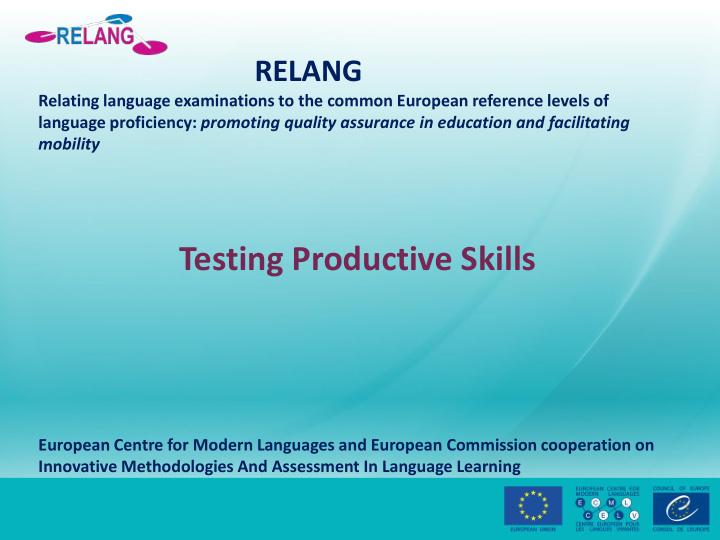



RELANG Relating language examinations to the common European reference levels of language proficiency: promoting quality assurance in education and facilitating mobility Testing Productive Skills European Centre for Modern Languages and European Commission cooperation on Innovative Methodologies And Assessment In Language Learning
Writing in the CEFR • Actions performed by persons • Illustrative scales for • Written production • Written interaction • Various contexts • CEFR Table 5, Descriptive categories • Communicative competences • Linguistic competence • Sociolinguistic competence • Pragmatic competence
Testing Writing
The Writing Process • Planning (brainstorming ideas or collecting them from various resources, noting down various ideas), • Drafting (writing out a rough version), • Reviewing (selecting the best ideas for inclusion, deciding on information for each paragraph and the order of paragraphs), • Editing (checking for unnecessary repetition of words and/or information, checking language use, punctuation and spelling).
Task characteristics • Stimulus as short and clear as possible – providing an adequate framework for candidates´ writing • Pictures/visual material can be used as stimulus – difficulties of interpretation • Candidates to know who they are writing to and how this will affect what they write
Text types and contexts • Production of different text types – Description – Narration – Argumentation, etc. • Production of texts in different contexts – Complaints – Requests – Invitations – Reports
Checklist for writing tasks 1. Is topic of text to be produced accessible to target candidates; is context realistic? 2. Is language in rubrics accessible to candidates at target level? 3. Is purpose of task clearly indicated? 4. Does task provide opportunity for candidates to show their range? 5. Is each task within word count? Is word count provided? 6. Is marking scheme provided? 7. Has sample answer for each task been provided?
Speaking in the CEFR • Actions performed by persons • Illustrative scales for – Spoken production – Spoken interaction • Various contexts – CEFR Table 5, Descriptive categories • Communicative competences – Linguistic competence – Sociolinguistic competence
Task characteristics • Stimulus as short and clear as possible • Stimulus to give adequate framework for candidates´ speaking • Pictures or other visual material can be used as stimulus – difficulties of interpretation • Candidates to know – who they are speaking to – how this information affects what they say
CEFR-based tasks • Factually oriented tasks – description – narration – instruction – comparison • Evaluative tasks – explanation – justification – prediction – decision
Role plays • Tasks to simulate social and service situations with fairly predictable structure – buying something – going to the restaurant • Intention is to simulate reality
Checklist for speaking tasks 1. Is topic of text to be produced accessible to candidates; is context realistic? 2. Is language in rubrics accessible to candidates at target level? 3. Is purpose of task clearly indicated? 4. Does task provide opportunity for candidates to show their range? 6. Is marking scheme provided?
Recommend
More recommend